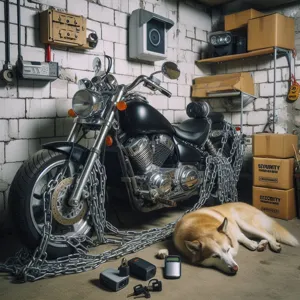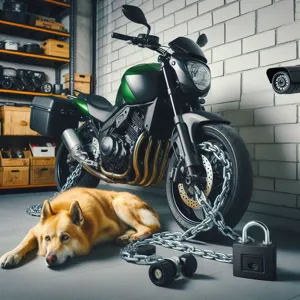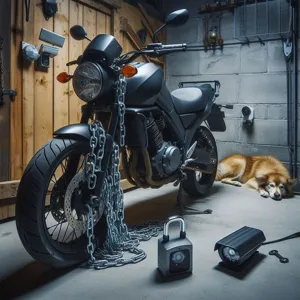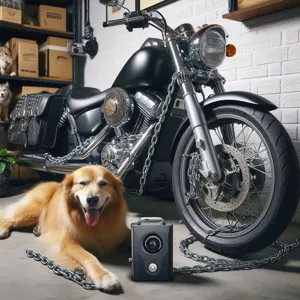Motorbikes are more than just a mode of transportation; they embody freedom, adventure, and a way of life for many enthusiasts.
However, the thrill of the open road can be overshadowed by the looming threat of theft, as motorbikes are often prime targets for criminals. The thought of losing your prized possession can be unsettling, but with the right precautions, you can significantly reduce the risk of theft and protect your investment. In this blog post, we’ll explore ten essential tips designed to safeguard your motorbike, from choosing the right locking mechanisms to understanding the importance of secure parking. Whether you’re a seasoned rider or a newcomer to the biking community, these practical strategies will empower you to enjoy your ride with peace of mind, knowing that your motorbike is well-protected against potential threats.
1. Understanding the Risks: The Importance of Theft Prevention

When it comes to motorbike ownership, understanding the risks associated with theft is paramount. Motorbikes, often seen as symbols of freedom and adventure, also attract the attention of opportunistic thieves. In urban areas, where the hustle and bustle of daily life makes it easier for criminals to blend in, the threat is particularly pronounced. However, even in quieter neighborhoods, motorbikes can be easy targets for those looking for a quick score.
Recognizing the importance of theft prevention goes beyond merely locking your bike. It involves a comprehensive understanding of where your bike is most vulnerable and what measures can be taken to mitigate those risks. This includes assessing your parking habits, the security of your storage area, and the types of locks and alarms you utilize. Thieves often employ various tactics, from picking locks and cutting chains to leveraging technology to override electronic systems. Therefore, being proactive in your approach is crucial.
Consider your surroundings: is your bike parked in a well-lit area with high foot traffic? Or is it tucked away in a dimly lit alley? The more you familiarize yourself with the potential threats, the better equipped you will be to safeguard your motorbike. Moreover, investing time in theft prevention can save you not only the heartache of losing your prized possession but also the financial burden of replacement and insurance premiums.
In summary, understanding the risks associated with motorbike theft is the first step towards effective prevention. By being aware of your environment and the tactics used by thieves, you can take the necessary precautions to protect your investment and enjoy the open road with peace of mind.
2. Invest in Quality Locks and Chains
When it comes to safeguarding your motorbike from theft, investing in quality locks and chains is one of the most crucial steps you can take. A flimsy lock may give you a false sense of security, but a robust, high-quality lock can significantly deter thieves. Look for locks that are made from hardened steel, as they are much more resistant to cutting, picking, and other forms of tampering.
Consider using a combination of lock types for added security. U-locks, chain locks, and disc locks, when used together, create multiple layers of protection. For instance, a thick chain lock can secure your bike to an immovable object, while a U-lock can secure the wheels or frame, making it harder for thieves to make off with your prized possession.
In addition to the type of lock, pay attention to the brand’s reputation. Brands that specialize in security equipment tend to offer products that have been rigorously tested for strength and durability. Look for locks that have been rated by independent testing organizations to ensure you’re getting the best protection possible.
Don’t forget about the placement of your locks, either. Always lock your bike in a well-lit, busy area and secure it at multiple points. This not only makes it more challenging for thieves but also increases the chances that someone will notice suspicious behavior. The more effort a thief has to put into stealing your motorbike, the less likely they are to attempt it. By investing in quality locks and chains, you’re making a smart choice that can save you from the heartache and expense of losing your motorbike to theft.
3. Choose the Right Parking Location

Choosing the right parking location for your motorbike is one of the most crucial steps in safeguarding it from theft. Not all parking spots are created equal; the environment in which you leave your bike can make a significant difference in its safety. When possible, opt for well-lit areas that are visible to foot traffic and security cameras. Thieves tend to shy away from locations that attract attention, so parking near entrances, busy walkways, or in areas with high visibility can deter potential thieves.
If you have access to a secure parking facility or a garage, take advantage of that option. Enclosed spaces not only protect your bike from the elements but also significantly reduce the risk of theft. If you must park on the street, look for designated motorcycle parking zones that often provide additional security measures. Always avoid secluded areas or spots that are poorly lit, as these conditions provide cover for thieves.
Additionally, consider the proximity to your final destination. If you’re visiting a popular area, try to park your bike closer to shops or establishments where there are likely to be other people around. Engaging with your surroundings can also provide an extra layer of safety; the more people are around, the less appealing your bike becomes to a thief. Remember, taking the time to choose the right parking location can be a simple yet effective strategy to keep your motorbike safe and secure.
4. Utilize an Alarm System
When it comes to safeguarding your motorbike from theft, one of the most effective deterrents you can employ is an alarm system. These sophisticated devices serve as both a warning to potential thieves and a reassuring signal to you that your bike is protected. Modern alarm systems come equipped with a variety of features that can enhance your bike’s security significantly.
For starters, look for alarms with motion sensors that can detect any unauthorized movement. This means that even the slightest attempt to tamper with or move your bike will trigger a loud siren, drawing attention and potentially scaring off thieves. Additionally, many systems now incorporate features like smartphone alerts, allowing you to receive real-time notifications if your bike is disturbed, no matter where you are.
Consider investing in a GPS tracking system as part of your alarm setup. This feature not only helps you locate your bike if it is stolen but can also assist law enforcement in recovering it. Many GPS systems allow you to set up geofencing alerts, notifying you if your motorbike leaves a predetermined area.
Installation is another crucial aspect to consider. A professionally installed alarm system can provide peace of mind, as experts can ensure that it is configured correctly and integrated seamlessly with your bike. If you prefer a more hands-on approach, there are DIY options available that come with detailed instructions and user-friendly interfaces.
Ultimately, utilizing an alarm system not only bolsters your motorbike’s defenses but also acts as a psychological barrier against would-be thieves. With the sound of an alarm echoing nearby, most will think twice before attempting to make off with your prized possession. Protect your investment and ride with confidence by incorporating an alarm system into your motorbike security strategy.
5. Consider GPS Tracking Devices

In an era where technology plays a pivotal role in enhancing security, equipping your motorbike with a GPS tracking device is a smart and proactive measure against theft. These compact, high-tech gadgets provide peace of mind by allowing you to monitor the location of your bike in real-time, no matter where you are.
Imagine this: you park your motorbike at a bustling café, only to discover later that it has vanished. With a GPS tracker installed, you can quickly access an app on your smartphone or a dedicated website to pinpoint its exact location. Many modern GPS devices come equipped with features such as geofencing, which sends alerts to your phone if your bike strays beyond a designated area. This means you can act swiftly if someone attempts to take off with your prized possession.
Moreover, GPS tracking devices are often compact and discreet, making them difficult for thieves to locate and disable. Many models are weatherproof and designed to withstand the rigors of daily riding, ensuring that your tracking capabilities are reliable in various conditions.
Investing in a GPS tracker not only increases your chances of recovering your motorbike if it is stolen but also serves as a deterrent to would-be thieves. The mere presence of a GPS device can make your bike less appealing to criminals, who know that the likelihood of getting caught increases significantly.
As you consider the various theft prevention strategies for your motorbike, incorporating a GPS tracking device into your security arsenal is a step that offers both safety and convenience, reinforcing your commitment to protecting your investment.
6. Secure Your Bike’s Components
When it comes to protecting your motorbike from theft, securing the individual components can be just as crucial as safeguarding the entire vehicle. Many thieves are opportunistic and will target specific items that can easily be detached and sold for quick cash, such as your seat, mirrors, or even the battery. By taking proactive measures to secure these components, you can significantly reduce the risk of losing valuable parts of your bike.
Start with your seat and mirrors; investing in high-quality anti-theft locks can deter would-be thieves. For seats, consider using a locking mechanism that secures it firmly to the frame, making it much more challenging for anyone to remove it quickly. Similarly, consider using lockable mirrors or lock nuts that require special tools to detach, adding an additional layer of security.
Don’t overlook your bike’s battery, which is often a target for thieves looking to make a quick buck. Battery locks or securing the battery with tamper-proof screws can help ensure it stays with your bike. Additionally, if you have aftermarket parts, consider marking them with a unique identifier or registering them with a database, making them traceable should theft occur.
Finally, consider investing in a comprehensive bike cover. Not only does it protect your motorbike from the elements, but it also serves as a visual deterrent. A covered bike is less enticing to thieves who prefer the easy pickings of an exposed vehicle. By securing your bike’s components and making them less accessible, you can significantly enhance your bike’s overall security and keep your investment safe from theft.
7. Use a Cover for Added Disguise

Using a cover for your motorbike is a simple yet effective way to enhance its security and deter potential thieves. While it might seem like a minor detail, a cover creates an additional layer of protection by disguising the motorcycle and keeping it out of plain sight. Thieves are typically attracted to vehicles that are easily visible and accessible; a covered bike becomes less of a target, as it obscures both the model and any valuable accessories you may have attached.
Opt for a high-quality, weather-resistant cover that fits snugly over your motorbike. Look for features such as reinforced seams, secure fastening straps, and breathable materials that prevent moisture buildup. A well-fitted cover not only protects against the elements—like rain, sun, and dust—but also adds an element of mystery, making it difficult for anyone passing by to gauge the bike’s true value.
Additionally, consider using a cover in a color that blends with its surroundings or is less conspicuous, further diminishing the likelihood of attracting unwanted attention. This strategy is especially useful if you park your motorbike in a public area or in a location with high foot traffic.
Remember, while a cover provides an extra layer of disguise, it should complement, not replace, other anti-theft measures you have in place. When combined with robust locks, alarms, and secure parking practices, a cover can significantly enhance your motorbike’s security, ensuring that it remains safely tucked away until you’re ready to ride.
8. Register Your Motorbike with the Authorities
Registering your motorbike with the authorities is a crucial step in safeguarding it from theft. Not only does this legal obligation help in establishing ownership, but it also plays a significant role in increasing the chances of recovery in case your bike is stolen. When you register your motorbike, you’re creating an official record that can be accessed by law enforcement and insurance companies, making your bike less attractive to potential thieves who often target unregistered vehicles.
Before you hit the road, ensure that you’ve submitted all the necessary paperwork to the relevant local or state authorities. This typically includes providing details such as the bike’s make, model, VIN (Vehicle Identification Number), and your personal information. Once registered, you’ll receive a registration document or certificate that serves as proof of ownership. Keep this document in a safe place, as it can be vital in proving that the bike is yours if it ever goes missing.
Additionally, many regions offer a motorcycle registration database that helps law enforcement track stolen vehicles. By having your bike registered, you enable authorities to quickly identify and return it to you if it’s recovered. Some insurance companies may even offer discounts on premiums for registered bikes, recognizing that they are less likely to be stolen or involved in fraudulent claims.
Finally, consider going beyond basic registration by utilizing microchipping or other identification methods, which can further deter thieves. By taking the time to register your motorbike properly, you’re not just protecting your investment; you’re also contributing to a safer motorcycle community overall. Remember, a little effort now can save you a lot of heartache later.
9. Join a Motorcycle Community or Association
Joining a motorcycle community or association is not just about camaraderie; it’s a strategic move to enhance your bike’s security. These groups often serve as a collective watchful eye, fostering an environment of mutual support and vigilance. When you become part of a community, you gain access to a wealth of knowledge and resources that are invaluable for safeguarding your motorbike.
Motorcycle communities often organize events, rides, and meetings where members share tips on the latest security practices, anti-theft devices, and even local crime trends. Many groups have dedicated forums or social media pages where members can post alerts about suspicious activities in their neighborhoods or nearby areas. This immediate access to information can be a game changer when it comes to preventing theft.
Moreover, being part of a community can provide you with discounts on insurance or security products. Many associations partner with local businesses to offer their members exclusive deals on locks, alarms, and other protective gear, making it easier and more affordable to enhance your bike’s security.
Additionally, members often participate in group rides, which not only promote safe riding habits but also reduce risk. Bikes riding in numbers are less likely to be targeted by thieves compared to those parked alone. The shared experiences within these groups can foster a sense of responsibility among members to keep an eye on each other’s bikes, creating a protective network that extends beyond individual ownership.
In essence, joining a motorcycle community or association amplifies your protective measures and builds a robust support system to deter theft, ensuring that you and your bike stay connected and secure on the road.
10. Regularly Maintain and Upgrade Security Features
Regularly maintaining and upgrading your motorbike’s security features is a crucial step in safeguarding your prized possession from theft. Just as you wouldn’t neglect routine maintenance on your bike’s engine or tires, the same diligence should apply to its security systems. Over time, technology evolves, and so do the tactics employed by thieves. Keeping your security measures current can make a significant difference in deterring potential theft.
Start with the basics: ensure your locks and chains are heavy-duty and in good condition. Check for any signs of wear or damage that could compromise their effectiveness. Investing in high-quality, tamper-resistant locks is essential, as many common locks can be easily bypassed. Opt for locks that have undergone rigorous testing and are recommended by security experts.
But don’t stop there—take advantage of the latest advancements in security technology. Consider installing a GPS tracking system that can help recover your bike in case it gets stolen. These devices can provide real-time location tracking and even send alerts to your phone if your bike is moved without your consent. Additionally, advanced alarm systems with motion sensors can be a great deterrent, emitting a loud sound to alert you and those nearby if someone attempts to tamper with your motorcycle.
Regularly updating your security features not only helps protect your bike but also offers peace of mind as you ride. Engage with your local motorcycle community to stay informed about the latest security trends and suggestions. A proactive approach to your motorbike’s security features will not only enhance its safety but also reinforce your commitment to protecting your investment. Ultimately, by staying vigilant and adaptable to changing security needs, you can help ensure your motorcycle remains where it belongs—safely parked and ready for your next adventure.
11. Create a Comprehensive Insurance Plan
When it comes to protecting your motorbike from theft, a comprehensive insurance plan is not just a safeguard—it’s a crucial component of your overall security strategy. While no one wants to think about the worst-case scenario, having the right insurance can provide you with peace of mind and financial protection should the unthinkable happen.
Start by exploring various insurance options tailored specifically for motorbike owners. Look for policies that cover theft and vandalism, as well as any potential damages resulting from an attempted theft. Comprehensive coverage typically includes the replacement cost of your bike, which can be especially valuable considering the rising prices of motorbikes and parts.
Don’t hesitate to ask your insurance provider about additional coverage options, such as roadside assistance or coverage for personal belongings stored on your bike. Some insurers even offer discounts for safety features like alarms, GPS trackers, or immobilizers, which can further enhance your bike’s security and lower your premiums.
Remember, not all insurance policies are created equal. Take the time to read the fine print, understand the terms, and assess any exclusions or limitations that may apply. Additionally, keep an eye on your deductible—the amount you will need to pay out of pocket before your insurance kicks in. A higher deductible may lower your monthly premium, but ensure it’s an amount you can comfortably afford in case of a claim.
Finally, don’t forget to periodically review and update your insurance plan. As the value of your motorbike changes over time, or if you make modifications that enhance its worth, it’s vital to ensure your coverage reflects these changes. By investing in a comprehensive insurance plan, you not only shield yourself financially but also bolster your overall strategy to keep your beloved motorbike safe from theft.
12. Be Aware of Your Surroundings
Being aware of your surroundings is crucial for safeguarding your motorbike from theft. Whether you’re parked in a bustling city or a quiet neighborhood, your vigilance can make a significant difference in preventing theft. Always take a moment to assess the area around you before leaving your bike. Look for well-lit spaces that are frequented by pedestrians; these spots are less attractive to potential thieves.
When parking, try to choose locations that are visible to others, such as near shops or busy cafes. If possible, opt for parking areas equipped with surveillance cameras or security personnel. Before you park, glance around for any suspicious behavior—individuals loitering too long or acting unusually may warrant caution.
It’s also wise to familiarize yourself with the local crime rates in different areas. If you frequently visit a location that has a history of theft, consider adjusting your parking strategy or investing in additional security measures.
Additionally, when you’re about to approach your bike after a stop, take a moment to scan the vicinity. Look for any unusual activity or individuals lingering nearby. This heightened awareness not only helps you protect your motorbike but also enhances your overall safety as a rider. Remember, the more conscious you are of your environment, the better equipped you are to thwart potential thieves and keep your beloved motorbike secure.
13. Document Your Bike’s Details
Documenting your bike’s details is a critical yet often overlooked step in safeguarding your motorbike from theft. Taking the time to create a comprehensive record of your motorcycle not only aids in recovery if it is ever stolen but also serves as a deterrent for thieves who may think twice when they know a bike has been meticulously cataloged.
Start by noting down essential details such as the make, model, year, and Vehicle Identification Number (VIN). This unique alphanumeric code is your bike’s fingerprint and can be instrumental in identifying it if it goes missing. Additionally, take clear, high-resolution photographs of your motorbike from various angles, capturing distinctive features, any custom modifications, and even scratches or dents that might help in proving ownership.
Don’t stop there—keep track of any receipts or documentation that relates to your motorcycle, including purchase invoices, maintenance records, and insurance papers. These documents not only provide proof of ownership but can also be crucial when filing a police report if your bike is stolen.
Storing this information securely is just as important as compiling it. Consider keeping a digital copy in a secure cloud storage service, as well as a physical copy in a safe place at home. Some riders even choose to register their motorcycle with anti-theft databases, which can further enhance the chances of recovery.
In the unfortunate event that your bike is ever stolen, having this detailed documentation at your fingertips will simplify the reporting process to law enforcement and your insurance company, allowing for a quicker response and potentially increasing the likelihood of recovering your beloved ride. Remember, taking these proactive steps can make a significant difference in your motorcycle’s security.
14. Share Tips with Fellow Riders
Sharing tips with fellow riders isn’t just a way to foster community; it’s a proactive strategy to enhance your collective security. Motorbike theft is a universal concern that affects riders from all walks of life, and by exchanging knowledge and experiences, you can help protect one another’s prized possessions.
Start by initiating conversations at local meetups or riding clubs. Share insights on the most effective locking mechanisms, the best places to park safely, and the latest security technology that can deter thieves. Online forums and social media groups dedicated to motorbike enthusiasts are also excellent platforms for discussing theft prevention strategies. By sharing your personal experiences—whether it’s a close call or a theft that you narrowly avoided—you can offer valuable lessons to your fellow riders.
You might also consider organizing workshops where seasoned riders can demonstrate various anti-theft devices, such as GPS trackers or innovative locks. Encourage group rides that emphasize safe parking practices and highlight the importance of being aware of your surroundings. The more informed your community is, the less likely they are to fall victim to theft.
In addition, consider creating a local alert system where riders can quickly share information about suspicious activity in the area. When everyone looks out for each other, the camaraderie deepens, and the risk of theft diminishes. Remember, it’s not just about safeguarding your own motorbike; it’s about building a resilient community that thrives on shared knowledge and mutual support. Together, you can create a safer environment for all riders, ensuring that your passion for the open road remains untainted by the threat of theft.
15. Conclusion: Staying Vigilant for Your Peace of Mind
As we draw this guide to a close, it’s essential to remember that safeguarding your motorbike from theft doesn’t end with the installation of high-tech security devices or the choice of an impenetrable lock. Staying vigilant is a continuous commitment that can significantly enhance your peace of mind and protect your investment.
The reality is that motorcycle theft can happen in the blink of an eye, and often when you least expect it. By remaining alert to your surroundings and adopting proactive habits, you can create a formidable barrier against potential thieves. Make it a routine to park in well-lit, crowded areas and familiarize yourself with your neighborhood’s safe zones. Engaging with fellow riders in your community can also provide valuable insights into local crime trends and preventative measures.
Regularly inspecting your bike for signs of tampering and keeping your registration details up to date are just a couple of the small, yet crucial steps you can take. Additionally, consider joining a motorcycle association or online forum where members share tips and tricks for enhanced security.
Ultimately, your motorbike is more than just a mode of transportation; it’s a reflection of your passion for the open road. By remaining vigilant and actively protecting your bike, you not only safeguard your investment but also ensure that the thrill of riding remains an enjoyable and worry-free experience. Stay alert, stay informed, and ride safe!
In conclusion, safeguarding your motorbike from theft requires a proactive approach and a combination of smart strategies. By implementing the 10 essential tips outlined in this post, you can significantly reduce the risk of theft and enjoy peace of mind while riding. From investing in high-quality locks and immobilizers to choosing secure parking spots and utilizing tracking devices, each step plays a crucial role in protecting your prized possession. Remember, a little extra effort today can save you from the heartbreak of losing your bike tomorrow. Stay vigilant, stay informed, and ride confidently knowing that you’ve taken the necessary precautions to keep your motorbike safe. Happy riding!




